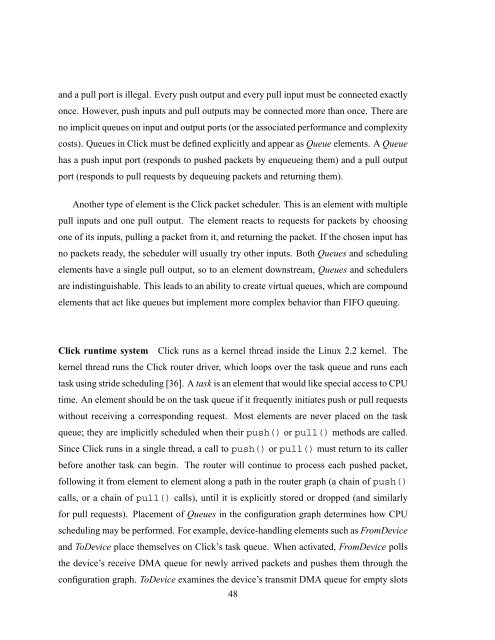Design and Implementation of TinyGALS: A Programming Model for ...
Design and Implementation of TinyGALS: A Programming Model for ...
Design and Implementation of TinyGALS: A Programming Model for ...
You also want an ePaper? Increase the reach of your titles
YUMPU automatically turns print PDFs into web optimized ePapers that Google loves.
<strong>and</strong> a pull port is illegal. Every push output <strong>and</strong> every pull input must be connected exactly<br />
once. However, push inputs <strong>and</strong> pull outputs may be connected more than once. There are<br />
no implicit queues on input <strong>and</strong> output ports (or the associated per<strong>for</strong>mance <strong>and</strong> complexity<br />
costs). Queues in Click must be defined explicitly <strong>and</strong> appear as Queue elements. A Queue<br />
has a push input port (responds to pushed packets by enqueueing them) <strong>and</strong> a pull output<br />
port (responds to pull requests by dequeuing packets <strong>and</strong> returning them).<br />
Another type <strong>of</strong> element is the Click packet scheduler. This is an element with multiple<br />
pull inputs <strong>and</strong> one pull output. The element reacts to requests <strong>for</strong> packets by choosing<br />
one <strong>of</strong> its inputs, pulling a packet from it, <strong>and</strong> returning the packet. If the chosen input has<br />
no packets ready, the scheduler will usually try other inputs. Both Queues <strong>and</strong> scheduling<br />
elements have a single pull output, so to an element downstream, Queues <strong>and</strong> schedulers<br />
are indistinguishable. This leads to an ability to create virtual queues, which are compound<br />
elements that act like queues but implement more complex behavior than FIFO queuing.<br />
Click runtime system Click runs as a kernel thread inside the Linux 2.2 kernel. The<br />
kernel thread runs the Click router driver, which loops over the task queue <strong>and</strong> runs each<br />
task using stride scheduling [36]. A task is an element that would like special access to CPU<br />
time. An element should be on the task queue if it frequently initiates push or pull requests<br />
without receiving a corresponding request. Most elements are never placed on the task<br />
queue; they are implicitly scheduled when their push() or pull() methods are called.<br />
Since Click runs in a single thread, a call to push() or pull() must return to its caller<br />
be<strong>for</strong>e another task can begin. The router will continue to process each pushed packet,<br />
following it from element to element along a path in the router graph (a chain <strong>of</strong> push()<br />
calls, or a chain <strong>of</strong> pull() calls), until it is explicitly stored or dropped (<strong>and</strong> similarly<br />
<strong>for</strong> pull requests). Placement <strong>of</strong> Queues in the configuration graph determines how CPU<br />
scheduling may be per<strong>for</strong>med. For example, device-h<strong>and</strong>ling elements such as FromDevice<br />
<strong>and</strong> ToDevice place themselves on Click’s task queue. When activated, FromDevice polls<br />
the device’s receive DMA queue <strong>for</strong> newly arrived packets <strong>and</strong> pushes them through the<br />
configuration graph. ToDevice examines the device’s transmit DMA queue <strong>for</strong> empty slots<br />
48
















